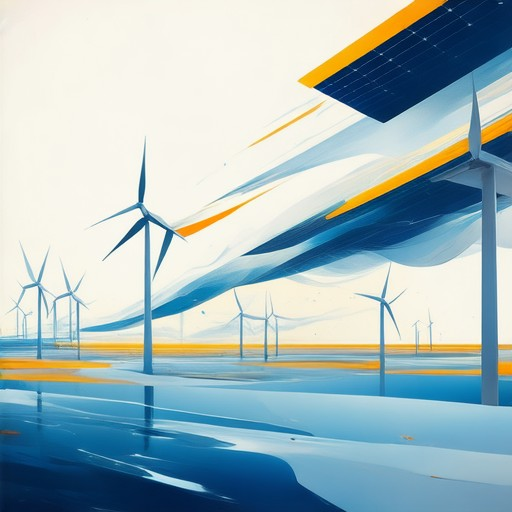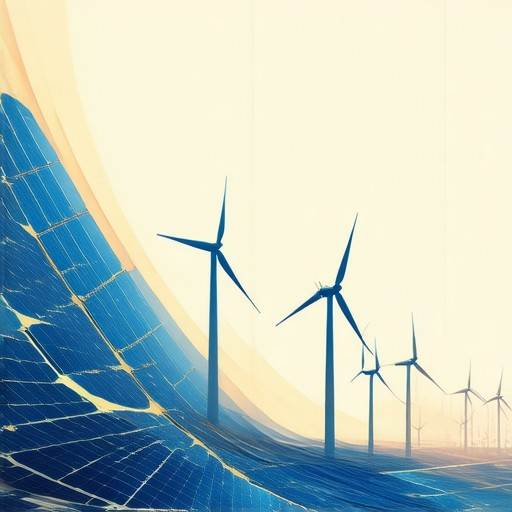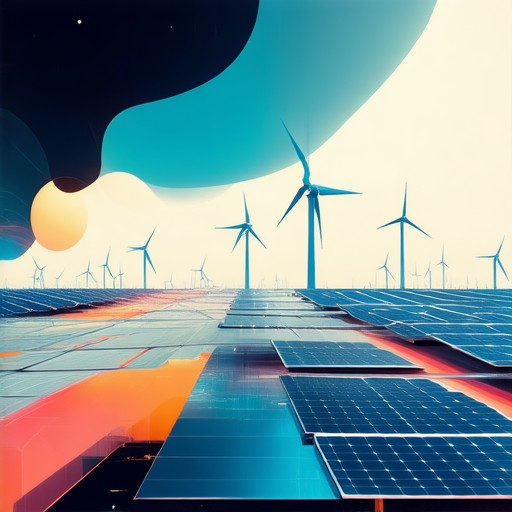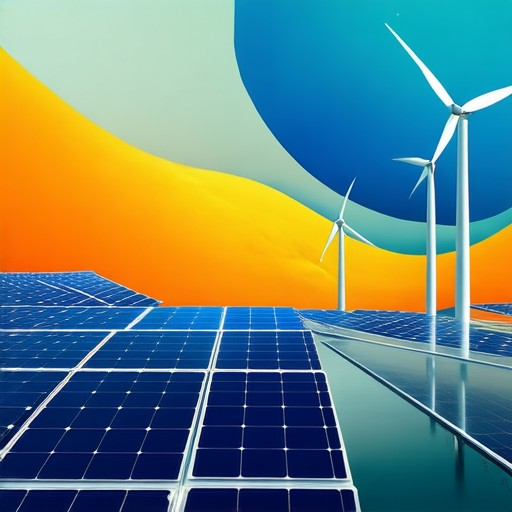Renewable energy installations are revolutionizing the way we approach energy consumption, offering cost-effective solutions and sustainable alternatives to traditional methods. As global demand for cleaner energy grows, so does the interest in understanding the various forms of renewable energy installations, their benefits, and how they can be effectively integrated into daily life. Whether it’s solar panels on rooftops, wind turbines in remote areas, or geothermal systems beneath the earth, renewable energy installations are paving the way for a greener future. This comprehensive exploration delves into the types of renewable energy available, the associated costs, and the most promising solutions, including a detailed comparison between green and renewable energy sources. By examining these factors, this article aims to provide clarity and guidance for those considering renewable energy installations, helping to unlock the full potential of sustainable energy.
Key Takeaways
– Main Renewable Energy Sources: Solar, wind, hydroelectric, geothermal, and bioenergy are the primary types of renewable energy, each offering unique benefits and applications.
– Most Promising Sources: Solar power, wind energy, and bioenergy stand out as highly promising due to their scalability, efficiency, and reduced environmental impact. Emerging technologies like tidal and wave energy, along with advancements in geothermal power, further enhance sustainability efforts.
– Green vs. Renewable Energy: Green energy refers to low-carbon sources, including renewable options like solar and wind, while renewable energy specifically comes from naturally replenishing resources. Both are essential for achieving sustainability goals, but their environmental impacts vary.

What is a Renewable Energy Installation?
A renewable energy installation refers to a system or facility that generates electricity or provides energy using renewable resources such as sunlight, wind, water, or biomass. These installations are designed to replace traditional non-renewable energy sources like fossil fuels, reducing reliance on finite resources and promoting sustainability.
Types of Renewable Energy Installations
- Solar PV Systems : Photovoltaic cells convert sunlight directly into electricity, which is then stored or used immediately.
- Wind Turbines : Rotating blades capture wind energy, converting it into mechanical power that drives an electric generator.
- Biomass Plants : Facilities that burn organic materials (like wood or agricultural waste) to produce energy.
- Geothermal Power Plants : Systems that harness the heat generated by Earth’s core to produce steam and generate electricity.
Benefits of Renewable Energy Installations
- Reduces greenhouse gas emissions
- Lowers dependence on fossil fuels
- Promotes energy independence
- Creates jobs in the renewable energy sector
- Provides a sustainable energy source for future generations
Competitors and Related Resources
Eco Planeta Verde encourages exploring other sustainable energy options as well. Some notable competitors in the renewable energy space include:- Renewable Energy Organization – Solar Power Europe – Global Wind Energy Council
By investing in renewable energy installations, we contribute to a cleaner, healthier planet for future generations. At Eco Planeta Verde, we advocate for responsible energy use and are committed to helping individuals and communities transition to sustainable energy solutions.
What Are the 7 Types of Renewable Energy?
Here’s a breakdown of the primary types of renewable energy:
- Solar Energy
- Derived from sunlight through photovoltaic panels, solar thermal systems, or solar farms.
- Widely used for residential, commercial, and large-scale applications.
- Benefits include reduced reliance on fossil fuels and lower electricity costs.
-
Wind Energy
- Generated by turbines that capture wind energy, often located offshore or on land.
- Utilizes both onshore and offshore wind farms for electricity production.
- Known for its scalability and ability to operate in diverse environments.
-
Hydroelectric Power
- Produced by harnessing the kinetic energy of flowing or falling water.
- Common methods include reservoir-based hydropower and run-of-the-river systems.
- Provides stable and consistent energy supply, making it a reliable source.
-
Geothermal Energy
- Extracted from the Earth’s heat stored beneath the surface.
- Used for heating buildings, generating electricity, and producing industrial steam.
- Offers long-term sustainability due to the Earth’s high heat capacity.
-
Bioenergy
- Derived from organic matter, including agricultural waste, forests, and sewage.
- Converted into energy through fermentation, anaerobic digestion, or incineration.
- Supports carbon sequestration and waste management initiatives.
-
Marine Energy
- Captured from ocean tides, waves, or currents using tidal, wave, or current turbines.
- Includes offshore wind farms and underwater turbines.
- Provides significant potential for remote coastal areas.
-
Hydrogen Energy
- Produced by electrolyzing water to create hydrogen gas.
- Can be used directly or converted into electricity via fuel cells.
- Seen as a promising energy carrier for storing and transporting renewable energy.
These renewable energy sources offer a diverse and sustainable approach to meeting global energy demands while minimizing environmental impact. By utilizing these technologies, we can transition toward a cleaner, greener future.

What is the Cheapest Renewable Energy to Install?
The cheapest renewable energy sources to install depend on various factors such as technology, scalability, and regional conditions. Here’s a breakdown of the most cost-effective options:
- Solar Energy : Solar panels remain one of the most accessible renewable energy options due to declining costs and technological advancements. Installation costs have significantly reduced over the years, making solar energy a viable choice for many homeowners and businesses.
- Wind Energy : Onshore wind farms are generally more cost-effective than offshore ones. With consistent wind patterns in certain regions, wind energy has become a competitive option for large-scale installations.
- Hydropower : Large-scale hydropower projects, such as those using dams, are often cost-effective, especially in areas with abundant water resources. However, environmental concerns sometimes limit its adoption.
- Geothermal Energy : Geothermal power is highly reliable and operates year-round, though initial capital costs can be substantial. Its cost-effectiveness depends on the specific resource characteristics of the area.
According to the CSIRO and AEMO’s GenCost 2021-22 report, wind and solar energy, along with battery storage, continue to lead as the cheapest sources of electricity in Australia. These technologies are expected to become even more affordable as costs decline further.
Eco Planeta Verde advocates for sustainable living solutions, encouraging individuals to explore these renewable energy options to reduce their carbon footprint effectively. By considering the specific needs and conditions of your region, you can choose the most suitable renewable energy source for your home or business.

What Are the 5 Main Renewable Energy Sources?
- Solar Energy
- Wind Energy
- Hydroelectric Power
- Geothermal Energy
- Bioenergy
Solar energy is derived from sunlight through photovoltaic cells or solar thermal systems.
- Solar Panels
- Solar Thermal Collectors
- Applications in Homes and Businesses
Wind energy harnesses the power of moving air to generate electricity via turbines.
- Wind Farms
- Turbines
- Onshore and Offshore Applications
Hydroelectric power involves the use of flowing water to drive turbines and generate electricity.
- Dams and Reservoirs
- Run-of-the-River Systems
- Large-Scale Plants
Geothermal energy is extracted from the Earth’s heat to generate electricity and provide heating.
- Hot Springs and Geysers
- Drilling and Extraction
- Energy Conversion Processes
Bioenergy produces energy from organic matter, typically through biomass conversion.
- Biomass Resources
- Biogas Production
- Waste-to-Energy Systems
What is the Most Promising Renewable Energy Source?
Eco Planeta Verde believes that renewable energy sources play a crucial role in achieving sustainability goals. Among the various options available, several stand out as highly promising due to their potential, efficiency, and scalability.
- Solar Power: Solar energy remains one of the most widely adopted renewable energy sources globally. Its scalability and accessibility make it a top contender for residential, commercial, and large-scale applications. Technologies like photovoltaic panels and concentrated solar power (CSP) continue to advance, making solar energy increasingly cost-effective and reliable.
- Wind Energy: Wind turbines harness the kinetic energy of moving air to generate electricity. While it depends heavily on regional conditions, offshore wind farms have shown great potential due to consistent wind speeds. Onshore wind energy is also expanding rapidly, contributing significantly to the global renewable energy mix.
- Hydroelectric Power: Hydropower generates electricity by utilizing the potential energy of flowing water. Large-scale projects like dams provide stable and significant amounts of energy, though concerns about environmental impact and habitat disruption remain. However, smaller, more sustainable hydropower solutions are gaining traction.
- Bioenergy: Derived from organic matter, bioenergy sources like biogas and biomass offer a sustainable alternative. Advanced biofuels produced from agricultural residues are increasingly seen as a promising solution, reducing greenhouse gas emissions while supporting rural economies.
Eco Planeta Verde recognizes the importance of exploring and investing in emerging renewable energy technologies. Innovations in tidal energy, wave energy, and geothermal power are showing promise, further diversifying our energy options and enhancing sustainability efforts worldwide.
For more information on renewable energy sources and sustainable living practices, visit our comprehensive resource hub at Eco Planeta Verde .

What is the Difference Between Green Energy and Renewable Energy?
Eco Planeta Verde helps individuals understand the key differences between green energy and renewable energy to make informed decisions about sustainable living.
- Green Energy: – Refers to energy sources that have a lower carbon footprint compared to traditional fossil fuels. – Includes both renewable and non-renewable energy sources, such as solar panels, wind turbines, geothermal energy, and even certain types of nuclear energy that use carbon capture technologies. – Focuses on reducing greenhouse gas emissions and promoting sustainable development.
- Renewable Energy: – Comes from sources that are naturally replenished, such as sunlight, wind, water, and organic materials like biomass. – Examples include solar panels, wind farms, hydroelectric power, and bioenergy. – While renewable energy is generally sustainable, not all forms of renewable energy are considered “green” due to potential environmental impacts, such as those associated with large-scale hydropower projects.
At Eco Planeta Verde, we advocate for the responsible use of both green and renewable energy sources to create a cleaner, more sustainable future. Visit our website to learn more about how you can integrate these energy sources into your daily life and reduce your carbon footprint.




0 Comments